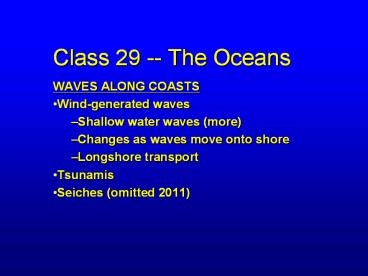Class 29 -- The Oceans - PowerPoint PPT Presentation
1 / 30
Title:
Class 29 -- The Oceans
Description:
Class 29 -- The Oceans WAVES ALONG COASTS Wind-generated waves Shallow water waves (more) Changes as waves move onto shore Longshore transport Tsunamis – PowerPoint PPT presentation
Number of Views:297
Avg rating:3.0/5.0
Title: Class 29 -- The Oceans
1
Class 29 -- The Oceans
- WAVES ALONG COASTS
- Wind-generated waves
- Shallow water waves (more)
- Changes as waves move onto shore
- Longshore transport
- Tsunamis
- Seiches (omitted 2011)
2
(No Transcript)
3
Changes in Wind-Generated Waves As They Move
Onshore
- 1. Changes in wave characteristics --
- Waves "feel bottom" in shallow water (D lt L/2).
- "Deep-Water waves --gt "Shallow Water" waves
- Shallower water --gt Slower, closer spacing
- T remains constant
- H increases (wave energy compressed into smaller
area)
4
Changes in Waves As They Move Onshore
- Wave Theory The shallow water wave model says
- When D lt L/20, S L controlled only by depth
- S vgD 3.13 vD
- Top of wave can crash forward as the bottom of
the wave slows down - If H/L gt 1/7 (D H) --gt "breakers," "surf"
5
(No Transcript)
6
(No Transcript)
7
Changes in Wind-Generated Waves As They Move
Onshore
Changes in wave direction
8
- (2) Changes in wave direction -- refraction
- If waves approach at an oblique angle...
- Bending of wave "fronts" (crests)
- Bending of wave movement direction
9
Why does refraction occur?
- a. Wave loses speed as water gets shallower
- b. The part of wave that is in shallow water
moves more slowly than the part in deep water - Result
- Wave movement direction turns toward shallow
water - Waves crests become closer to parallel with shore
10
Beach
11
(No Transcript)
12
- Refraction irregular shapes of coastlines
causes - a) Focussing of wave energy onto headlands or
shallower parts of beaches
13
- Refraction irregular shapes of coastlines
causes - b) Quieter conditions on recessed beaches
- c) Erosion in headlands and deposition of
sediment in recessed areas
14
- Tsunamis video
http//www.youtube.com/watch?vPBZGH3yieLc model
http//www.youtube.com/watch?v5-zfCBCq-8I sea
wall
http//www.nytimes.com/2011/03/13/weekinreview/13w
ater.html?refscience weight of water
http//www.nytimes.com/interactive/2011/03/11/worl
d/asia/maps-of-earthquake-and-tsunami-damage-in-ja
pan.html?refscience Maps and block diagrams
15
Tsunami Very long wavelength waves caused by
earthquakes, etc.
16
Tsunami Very long wavelength waves caused by
earthquakes, etc.
- Example Earthquake Sea floor drops 6m
- T 10 -20 min (600-1,200 s)
- L 100 - 200 km (100,000 - 200,000 m)
- H 1 - 2 m when water is deep -- not noticeable
17
Tsunami Very long wavelength
- L 100 - 200 km (100,000 - 200,000 m)
- How deep is the ocean- average???
- The Shallow-water wave model applies
- The waves are REFRACTED
18
2011 Honshu Tsunami Simulation- NOAA
19
Tsunami Very long wavelength waves caused by
earthquakes, etc.
- Example Earthquake Sea floor drops 6m
- T 10 -20 min (600-1,200 s)
- L 100 - 200 km (100,000 - 200,000 m)
- H 1 - 2 m -- not noticeable in open ocean!
- Behave like Shallow-water waves L gtgt depth of
ocean - Thus, speed controlled by depth only (wave
theory) - S vgD 200 m/s (400 mph)
20
Tsunami changes as it moves into shallower water
21
http//www.youtube.com/watch?v3q9gC8mQNhk (Japane
se Coast Guard vessel rides tsunami)
22
TSUNAMIS in coastal areas
- H 1-2 m in open ocean, long L
- But as they move onshore
- S decreases
- L decreases (compresses waves)
- 2. H increases to perhaps 20 m, but wavelength
is long, so these waves act like floods, not
breakers - 3. Energy focused by bottom topography and
man-made barriers
23
(No Transcript)
24
Damage in Crescent City, CA, March 2011 Tsunami
from Japan
25
- Prediction of tsunamis
- Earthquake event
- Large vertical displacement required
- Many large quakes --gt no tsunami
- Can predict wave migration
- Plenty of time to warn people
26
- Prediction of tsunamis
- http//nctr.pmel.noaa.gov/animate.html
27
(No Transcript)
28
SEICHES (Omitted 2011)
- Standing waves- they dont move
- Sloshing back and forth- bathtub
- Occur in harbors, bays
- Natural resonance period (T) of a basin
- Depends on depth and dimensions
- If entering wave has same T, it resonates" in
basin - Water moves back and forth, up and down
- Winds, tides, and waves can cause seiches
29
(No Transcript)
30
(No Transcript)































